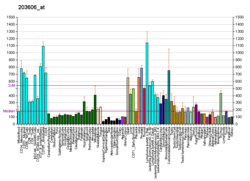NDUFS6
NADH dehydrogenase [ubiquinone] iron-sulfur protein 6, mitochondrial is an enzyme that in humans is encoded by the NDUFS6 gene.[4][5]
Function
The multisubunit NADH:ubiquinone oxidoreductase (complex I) is the first enzyme complex in the electron transport chain of mitochondria. The iron-sulfur protein (IP) fraction is made up of 7 subunits, including NDUFS6.[5]
Clinical significance
Mutations in the NDUFS6 gene are associated with mitochondrial Complex I deficiency, and are inherited in an autosomal recessive manner. This deficiency is the most common enzymatic defect of the oxidative phosphorylation disorders.[6][7] Mitochondrial complex I deficiency shows extreme genetic heterogeneity and can be caused by mutation in nuclear-encoded genes or in mitochondrial-encoded genes. There are no obvious genotype-phenotype correlations, and inference of the underlying basis from the clinical or biochemical presentation is difficult, if not impossible.[8] However, the majority of cases are caused by mutations in nuclear-encoded genes.[9][10] It causes a wide range of clinical disorders, ranging from lethal neonatal disease to adult-onset neurodegenerative disorders. Phenotypes include macrocephaly with progressive leukodystrophy, nonspecific encephalopathy, hypertrophic cardiomyopathy, myopathy, liver disease, Leigh syndrome, Leber hereditary optic neuropathy, and some forms of Parkinson disease[11].
In NDUFS6 mutations the presentation is typically a neonatal lactic acidosis that is swiftly fatal, coupled with multi-system failure[6][8][11].
See also
References
- 1 2 3 GRCh38: Ensembl release 89: ENSG00000145494 - Ensembl, May 2017
- ↑ "Human PubMed Reference:".
- ↑ "Mouse PubMed Reference:".
- ↑ Emahazion T, Beskow A, Gyllensten U, Brookes AJ (Nov 1998). "Intron based radiation hybrid mapping of 15 complex I genes of the human electron transport chain". Cytogenetics and Cell Genetics. 82 (1-2): 115–9. PMID 9763677. doi:10.1159/000015082.
- 1 2 "Entrez Gene: NDUFS6 NADH dehydrogenase (ubiquinone) Fe-S protein 6, 13kDa (NADH-coenzyme Q reductase)".
- 1 2 Kirby DM, Salemi R, Sugiana C, Ohtake A, Parry L, Bell KM, Kirk EP, Boneh A, Taylor RW, Dahl HH, Ryan MT, Thorburn DR (Sep 2004). "NDUFS6 mutations are a novel cause of lethal neonatal mitochondrial complex I deficiency". The Journal of Clinical Investigation. 114 (6): 837–45. PMC 516258
 . PMID 15372108. doi:10.1172/JCI20683.
. PMID 15372108. doi:10.1172/JCI20683. - ↑ McFarland R, Kirby DM, Fowler KJ, Ohtake A, Ryan MT, Amor DJ, Fletcher JM, Dixon JW, Collins FA, Turnbull DM, Taylor RW, Thorburn DR (Jan 2004). "De novo mutations in the mitochondrial ND3 gene as a cause of infantile mitochondrial encephalopathy and complex I deficiency". Annals of Neurology. 55 (1): 58–64. PMID 14705112. doi:10.1002/ana.10787.
- 1 2 Haack TB, Haberberger B, Frisch EM, Wieland T, Iuso A, Gorza M, Strecker V, Graf E, Mayr JA, Herberg U, Hennermann JB, Klopstock T, Kuhn KA, Ahting U, Sperl W, Wilichowski E, Hoffmann GF, Tesarova M, Hansikova H, Zeman J, Plecko B, Zeviani M, Wittig I, Strom TM, Schuelke M, Freisinger P, Meitinger T, Prokisch H (Apr 2012). "Molecular diagnosis in mitochondrial complex I deficiency using exome sequencing". Journal of Medical Genetics. 49 (4): 277–83. PMID 22499348. doi:10.1136/jmedgenet-2012-100846.
- ↑ Loeffen JL, Smeitink JA, Trijbels JM, Janssen AJ, Triepels RH, Sengers RC, van den Heuvel LP (2000). "Isolated complex I deficiency in children: clinical, biochemical and genetic aspects". Human Mutation. 15 (2): 123–34. PMID 10649489. doi:10.1002/(SICI)1098-1004(200002)15:2<123::AID-HUMU1>3.0.CO;2-P.
- ↑ Triepels RH, Van Den Heuvel LP, Trijbels JM, Smeitink JA (2001). "Respiratory chain complex I deficiency". American Journal of Medical Genetics. 106 (1): 37–45. PMID 11579423. doi:10.1002/ajmg.1397.
- 1 2 Robinson BH (May 1998). "Human complex I deficiency: clinical spectrum and involvement of oxygen free radicals in the pathogenicity of the defect". Biochimica et Biophysica Acta. 1364 (2): 271–86. PMID 9593934. doi:10.1016/s0005-2728(98)00033-4.
Further reading
- Loeffen J, van den Heuvel L, Smeets R, Triepels R, Sengers R, Trijbels F, Smeitink J (Jun 1998). "cDNA sequence and chromosomal localization of the remaining three human nuclear encoded iron sulphur protein (IP) subunits of complex I: the human IP fraction is completed". Biochemical and Biophysical Research Communications. 247 (3): 751–8. PMID 9647766. doi:10.1006/bbrc.1998.8882.
- Loeffen JL, Triepels RH, van den Heuvel LP, Schuelke M, Buskens CA, Smeets RJ, Trijbels JM, Smeitink JA (Dec 1998). "cDNA of eight nuclear encoded subunits of NADH:ubiquinone oxidoreductase: human complex I cDNA characterization completed". Biochemical and Biophysical Research Communications. 253 (2): 415–22. PMID 9878551. doi:10.1006/bbrc.1998.9786.
- Brandenberger R, Wei H, Zhang S, Lei S, Murage J, Fisk GJ, Li Y, Xu C, Fang R, Guegler K, Rao MS, Mandalam R, Lebkowski J, Stanton LW (Jun 2004). "Transcriptome characterization elucidates signaling networks that control human ES cell growth and differentiation". Nature Biotechnology. 22 (6): 707–16. PMID 15146197. doi:10.1038/nbt971.
- Kirby DM, Salemi R, Sugiana C, Ohtake A, Parry L, Bell KM, Kirk EP, Boneh A, Taylor RW, Dahl HH, Ryan MT, Thorburn DR (Sep 2004). "NDUFS6 mutations are a novel cause of lethal neonatal mitochondrial complex I deficiency". The Journal of Clinical Investigation. 114 (6): 837–45. PMC 516258
 . PMID 15372108. doi:10.1172/JCI20683.
. PMID 15372108. doi:10.1172/JCI20683. - Oh JH, Yang JO, Hahn Y, Kim MR, Byun SS, Jeon YJ, Kim JM, Song KS, Noh SM, Kim S, Yoo HS, Kim YS, Kim NS (Dec 2005). "Transcriptome analysis of human gastric cancer". Mammalian Genome. 16 (12): 942–54. PMID 16341674. doi:10.1007/s00335-005-0075-2.
- Lazarou M, McKenzie M, Ohtake A, Thorburn DR, Ryan MT (Jun 2007). "Analysis of the assembly profiles for mitochondrial- and nuclear-DNA-encoded subunits into complex I". Molecular and Cellular Biology. 27 (12): 4228–37. PMC 1900046
 . PMID 17438127. doi:10.1128/MCB.00074-07.
. PMID 17438127. doi:10.1128/MCB.00074-07.


